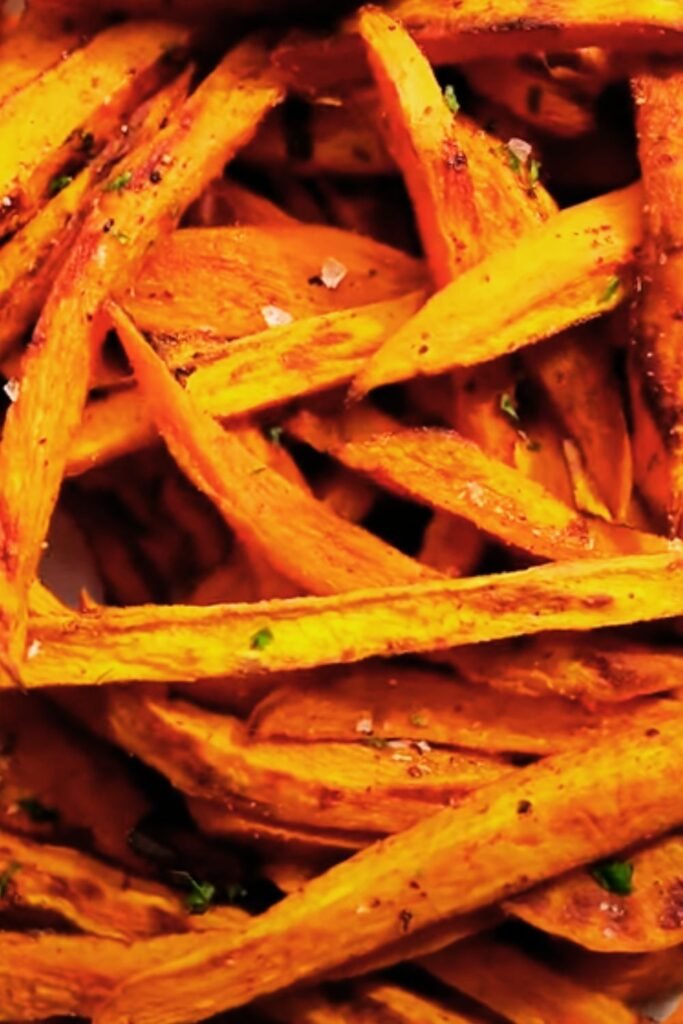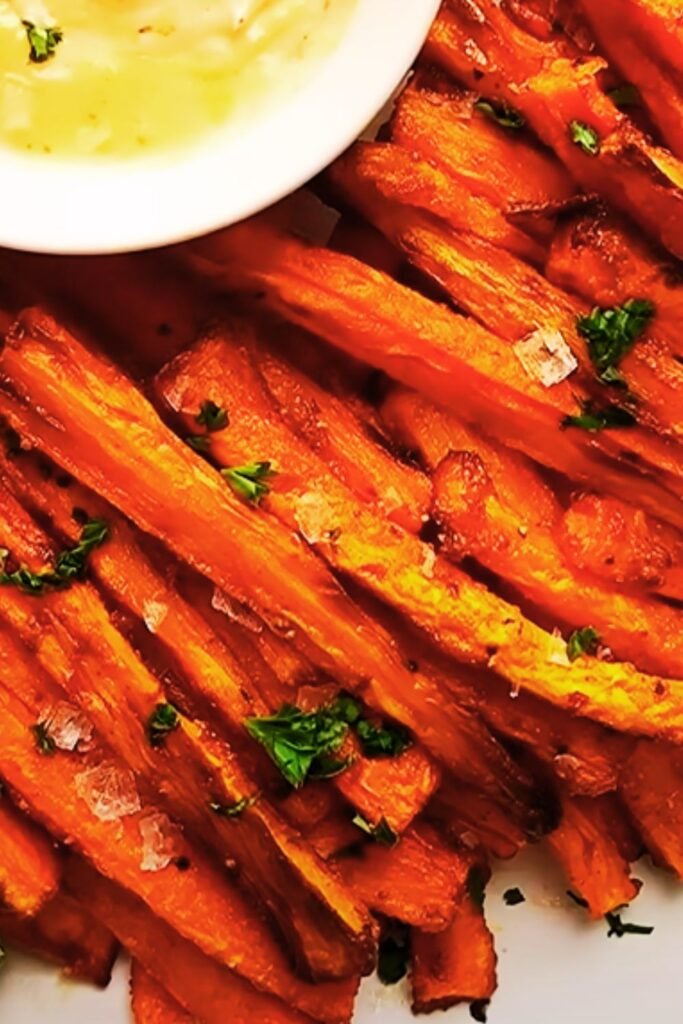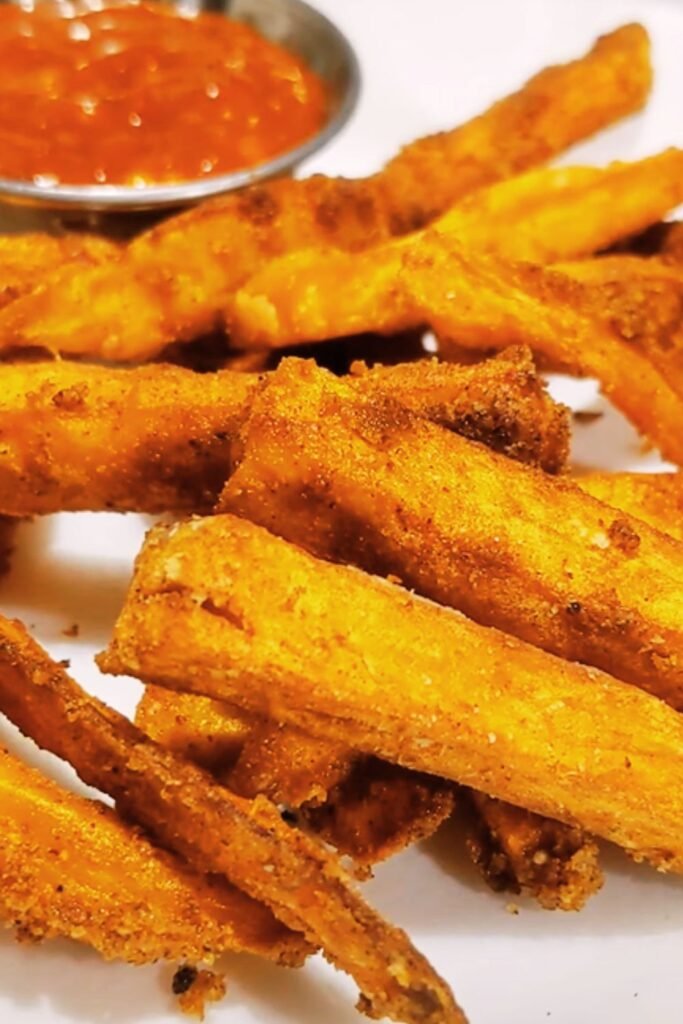Have you ever tried making sweet potato fries at home only to end up with soggy, limp disappointments instead of the crispy, golden delights you were craving? Trust me, I’ve been there—more times than I care to admit. After countless batches and many “learning experiences” (aka failures), I’ve finally cracked the code to consistently perfect, restaurant-quality sweet potato fries made right in your own kitchen.
Sweet potato fries should strike that magical balance: crispy and slightly caramelized on the outside, tender and fluffy on the inside, with that perfect sweet-savory flavor profile that makes them irresistible. Today, I’m sharing every single secret I’ve discovered to help you achieve sweet potato fry perfection.
Why Sweet Potato Fries Are Worth Mastering
Before we dive into the recipe, let’s talk about why sweet potato fries deserve a spot in your cooking repertoire:
- Sweet potatoes are nutritional powerhouses packed with vitamin A, vitamin C, manganese, and fiber
- They offer a lower glycemic index than regular potatoes
- The natural sweetness pairs wonderfully with both savory and spicy flavors
- They add vibrant color to any meal
- They’re incredibly versatile and complement nearly any main dish
Once you master this recipe, you’ll have a go-to side dish that’s impressive enough for guests but easy enough for weeknight dinners. Let’s get started!
The Science Behind Crispy Sweet Potato Fries
The challenge with sweet potato fries lies in their composition. Sweet potatoes contain more moisture and sugar than regular potatoes, which makes achieving crispiness more difficult. When you understand the science, you can overcome these challenges.
Here’s what we need to address:
- Moisture content: Sweet potatoes have high moisture content that needs to be reduced before frying or baking
- Sugar content: The natural sugars caramelize quickly, sometimes before the fries can crisp up
- Starch structure: Sweet potatoes have a different starch structure than regular potatoes
My recipe tackles each of these issues systematically to ensure crispy results every time.
Essential Ingredients
For basic crispy sweet potato fries (serves 4):
| Ingredient | Amount | Notes |
|---|---|---|
| Sweet potatoes | 2 large (about 1.5 pounds) | Choose firm, evenly-shaped potatoes |
| Cornstarch | 2 tablespoons | Creates an ultra-thin coating that crisps beautifully |
| Olive oil | 3 tablespoons | Use high-quality oil for best flavor |
| Salt | 1 teaspoon | Kosher or sea salt preferred |
| Black pepper | ¼ teaspoon | Freshly ground |
| Garlic powder | ½ teaspoon | Optional but recommended |
| Paprika | ½ teaspoon | Adds color and mild flavor |
Equipment You’ll Need
| Equipment | Purpose |
|---|---|
| Sharp chef’s knife | For precise, even cutting |
| Large cutting board | Provides stable surface for cutting |
| Large bowl | For tossing fries with cornstarch and seasonings |
| Colander | For draining soaked potatoes |
| Baking sheets | Two is ideal, don’t overcrowd! |
| Parchment paper | Prevents sticking and aids browning |
| Instant-read thermometer | If deep-frying |
| Cooling rack | For maximum crispiness after cooking |

The Step-by-Step Process
Preparation Phase
- Select the right sweet potatoes: Look for firm, smooth sweet potatoes without wrinkles or soft spots. Medium-sized potatoes with uniform shape will cook most evenly.
- Wash and peel: Scrub sweet potatoes thoroughly under cold running water. While you can leave the skin on for extra nutrition, peeling produces more consistently crispy results.
- Cut consistently: The secret to evenly cooked fries is uniform size. Here’s how I do it:
- Cut the sweet potato in half lengthwise
- Place each half flat-side down and cut into ¼-inch planks
- Stack the planks and cut into ¼-inch sticks
- Aim for fries that are approximately ¼-inch by ¼-inch by 3-4 inches long
- The cold water soak: This is non-negotiable! Place cut fries in a large bowl and cover completely with cold water. Let them soak for at least 1 hour (or up to overnight in the refrigerator). This draws out excess starch and moisture—essential for crispiness.
- Dry thoroughly: After soaking, drain the fries in a colander, then spread them on clean kitchen towels or paper towels. Pat completely dry. Any remaining moisture will create steam during cooking, which is the enemy of crispiness.
The Cornstarch Coating Method
- Place the dried sweet potato fries in a large plastic bag or bowl.
- Add the cornstarch and seal the bag (or cover the bowl).
- Shake or toss until all fries are lightly coated with a thin, barely visible layer of cornstarch.
- Transfer to a clean bowl, drizzle with olive oil, and add seasonings.
- Toss gently until evenly coated.
Baking Method (Healthier Option)
- Preheat properly: Set your oven to 425°F (220°C) and allow it to fully preheat. Position racks in the upper and lower thirds of the oven.
- Prepare baking sheets: Line two large baking sheets with parchment paper. Using two sheets prevents overcrowding, which is crucial for crispiness.
- Arrange fries: Spread the coated fries in a single layer on the baking sheets, ensuring no fries are touching each other. This allows hot air to circulate around each fry.
- The two-temperature technique:
- Bake at 425°F for 15 minutes
- Flip each fry with tongs or a spatula
- Reduce heat to 400°F (200°C) and bake for another 10-15 minutes until edges are crisp and slightly darkened
- The final crisp: Turn off the oven, crack the door open, and leave fries inside for 10 minutes. This allows excess moisture to escape while maintaining heat.
Deep-Frying Method (Crispiest Results)
- Heat oil properly: In a large, heavy-bottomed pot, heat vegetable or peanut oil to 325°F (165°C). Use enough oil to completely submerge the fries, approximately 3-4 inches deep.
- Fry in batches: Carefully add sweet potato fries to the hot oil in small batches—overcrowding causes the temperature to drop too much. Each batch should take about 5-6 minutes.
- The double-fry technique:
- First fry: 325°F (165°C) for 3 minutes to cook the interior
- Remove and drain on paper towels
- Second fry: Increase oil to 350°F (175°C) and fry again for 2-3 minutes until golden and crisp
- Drain properly: After frying, drain on a wire rack set over a baking sheet rather than on paper towels. This prevents the fries from steaming underneath.

Seasoning Variations
The beauty of sweet potato fries is their versatility. Here are some of my favorite seasoning combinations to try:
| Seasoning Profile | Ingredients | Perfect Pairings |
|---|---|---|
| Classic | Salt, black pepper, garlic powder | Burgers, sandwiches |
| Spicy | Cayenne pepper, chili powder, cumin | Mexican dishes, spicy chicken |
| Sweet & Spicy | Brown sugar, cinnamon, cayenne | BBQ, pork dishes |
| Herb Garden | Rosemary, thyme, sage, garlic | Roasted chicken, turkey |
| Smoky | Smoked paprika, garlic powder, onion powder | Grilled meats, brisket |
| Curry | Curry powder, garlic powder, ginger | Indian or Thai main courses |
| Italian | Dried basil, oregano, parmesan | Pizza, pasta dishes |
Always add your seasonings immediately after cooking while the fries are still hot—they’ll adhere better and the heat will help bloom the spices, intensifying their flavor.
Dipping Sauce Recipes
No sweet potato fry experience is complete without amazing dipping sauces. Here are three easy homemade options that perfectly complement the sweet-savory profile of these fries:
Maple Dijon Aioli
| Ingredient | Amount |
|---|---|
| Mayonnaise | ⅓ cup |
| Dijon mustard | 1 tablespoon |
| Pure maple syrup | 1 tablespoon |
| Lemon juice | 1 teaspoon |
| Garlic | 1 small clove, minced |
| Salt and pepper | To taste |
Mix all ingredients in a small bowl until smooth. Refrigerate for at least 30 minutes before serving to allow flavors to meld.
Spicy Sriracha Cream
| Ingredient | Amount |
|---|---|
| Sour cream | ¼ cup |
| Greek yogurt | ¼ cup |
| Sriracha sauce | 1-2 tablespoons (adjust to taste) |
| Lime juice | 1 teaspoon |
| Honey | 1 teaspoon |
| Salt | Pinch |
Whisk all ingredients together until smooth. Start with less sriracha and add more to reach your desired heat level.
Roasted Garlic Ketchup
| Ingredient | Amount |
|---|---|
| Ketchup | ½ cup |
| Roasted garlic | 2-3 cloves, mashed |
| Balsamic vinegar | 1 teaspoon |
| Brown sugar | ½ teaspoon |
| Smoked paprika | ¼ teaspoon |
Combine all ingredients in a small bowl. Let stand at room temperature for 15 minutes before serving.
Troubleshooting Common Problems
| Problem | Cause | Solution |
|---|---|---|
| Fries are soggy | Too much moisture, overcrowding | Dry thoroughly after soaking, use two baking sheets, increase oven temperature |
| Burnt exterior, raw interior | Cut too thick, oven too hot | Cut fries to uniform ¼-inch thickness, reduce oven temperature |
| Fries stick to baking sheet | No parchment paper, not enough oil | Always use parchment paper, ensure fries are evenly coated with oil |
| Fries cook unevenly | Inconsistent sizes, oven hot spots | Cut fries uniformly, rotate baking sheets halfway through cooking |
| Not crispy enough | Skipped cornstarch, not dry enough | Always use cornstarch coating, ensure fries are completely dry before baking |

Serving Suggestions
Sweet potato fries make a fantastic side dish for countless meals. Here are some perfect pairings:
- Grilled chicken or turkey burgers
- Veggie burgers or black bean burgers
- Pulled pork or brisket sandwiches
- Fish tacos or grilled fish
- Salads (they add a great crunchy element)
- Grain bowls for texture contrast
- As part of a casual appetizer spread
- Alongside soup for a satisfying lunch
For a complete meal, consider serving with a fresh green salad or crunchy coleslaw to balance the richness of the fries.
Storage and Reheating
Sweet potato fries are best enjoyed immediately after cooking, as they tend to soften during storage. However, if you have leftovers:
- Refrigeration: Store in an airtight container for up to 3 days.
- Reheating for maximum crispiness:
- Preheat oven to 400°F (200°C)
- Spread fries on a baking sheet in a single layer
- Bake for 5-7 minutes until heated through and crisp
- Avoid microwaving, which will make them soggy
- Make ahead option: You can prepare the fries through the soaking and drying stage, then refrigerate for up to 24 hours before cooking.
Health Benefits of Sweet Potatoes
Sweet potatoes aren’t just delicious—they’re nutritional superstars that make these fries a better-for-you option:
| Nutrient | Benefit |
|---|---|
| Beta-carotene | Converted to vitamin A in the body; supports eye health and immune function |
| Vitamin C | Boosts immune system and promotes collagen production |
| Manganese | Supports bone health and helps metabolize nutrients |
| Fiber | Promotes gut health and helps maintain steady blood sugar |
| Antioxidants | Help reduce inflammation and oxidative stress |
| Potassium | Supports heart health and helps regulate blood pressure |
Baking rather than frying and keeping the skin on adds even more nutritional benefits to your sweet potato fries.
Q&A Section
Q: Why do my sweet potato fries always turn out soggy despite following recipes?
A: The most likely culprits are not removing enough moisture or overcrowding your baking sheet. The cold water soak followed by thorough drying is absolutely essential. Also, make sure your fries have plenty of space on the baking sheet—use two sheets if necessary. The cornstarch coating also makes a huge difference in achieving crispiness.
Q: Can I make these fries in an air fryer?
A: Absolutely! Air fryers are excellent for sweet potato fries. Prepare them as directed through the cornstarch and seasoning step, then air fry at 380°F (190°C) for about 12-15 minutes, shaking the basket halfway through cooking. You may need to work in batches depending on your air fryer size.
Q: Do I really need to soak the sweet potatoes? I’m short on time.
A: The soaking step is crucial for removing excess starch and moisture. If you’re truly pressed for time, you can reduce the soak to 30 minutes, but I don’t recommend skipping it entirely. If planning ahead, cut and soak your sweet potatoes the night before, then drain, dry, and cook them the next day.
Q: Are sweet potato fries healthier than regular fries?
A: Sweet potato fries offer different nutritional benefits than regular fries—they’re higher in vitamin A, vitamin C, and some antioxidants, while regular potatoes have more potassium. Both can be part of a healthy diet when baked rather than deep-fried and enjoyed in moderation. The cooking method matters more than the type of potato from a calorie perspective.
Q: My fries burn on the outside before cooking through. What am I doing wrong?
A: This usually happens when the fries are cut too thick or the oven temperature is too high. Make sure your fries are cut to a consistent ¼-inch thickness. You can also try the two-temperature technique in my recipe: start at higher heat, then reduce the temperature to allow the interior to cook through without burning the exterior.
Q: Can these be made without oil for an oil-free diet?
A: While some oil helps achieve crispiness, you can reduce the oil significantly. Try using just 1 tablespoon or use an oil mister for the lightest possible coating. Another option is using parchment paper and a very light spray of oil, though the results won’t be quite as crispy as the full recipe.
Q: How do you keep sweet potato fries from sticking to the pan?
A: Always use parchment paper on your baking sheet—this is non-negotiable! The cornstarch coating also helps prevent sticking. Make sure your fries are well-coated with oil before arranging them on the parchment paper, and don’t try to flip them until they’ve developed a crust on the bottom.
Q: Can I freeze sweet potato fries?
A: Yes! To freeze:
- Cut and soak sweet potatoes as directed
- Blanch in boiling water for 2 minutes, then shock in ice water
- Dry thoroughly and arrange on a baking sheet
- Freeze until solid, then transfer to freezer bags
- When ready to cook, toss frozen fries with cornstarch, oil, and seasonings, and bake as directed, adding a few extra minutes to the cooking time
Final Tips for Sweet Potato Fry Success
After making countless batches of sweet potato fries, I’ve discovered these final pro tips that make all the difference:
- Consistency is key: Take the time to cut your fries to uniform thickness. It’s worth the extra few minutes of careful cutting.
- Don’t rush the process: Each step—from soaking to thorough drying to proper spacing on the baking sheet—plays a crucial role in achieving crispiness.
- Season right: Always add your seasonings after the cornstarch and oil coating for maximum flavor adhesion.
- Temperature matters: A hot oven is essential. If your oven runs cool, consider increasing the temperature by 25 degrees.
- Eat immediately: Sweet potato fries are at their absolute best right after cooking. The longer they sit, the softer they become.
With these techniques and tips in your culinary toolkit, you’ll be able to create restaurant-quality sweet potato fries that are crispy, flavorful, and absolutely irresistible. Your friends and family will be amazed at how you’ve mastered what many consider an impossible cooking challenge. Happy cooking!